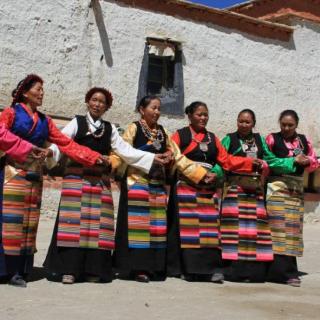
介绍:
Located in western Tibet's Ngari region, the towering ruins of Guge Kingdom are just like the Giza Pyramids on the roof of the world. Founded during the 10th century, this once-mighty regime mysteriously collapsed after seven-hundred-year rule and left us only a few frescoes and statues to reminisce its former glory.
But in the eyes of local conservator Pasang Tsering, there is something from the Kingdom that withstands the test of time.
Pointing at a piece of mural which profiles ten women crossing arms, he explains.
"This is a kind of religious dance. It is said that the dance was first performed at particular rituals. Other studies show that the dance originated from Bon, a Tibetan indigenous religion, since dancers would spin counterclockwise like their prayers do. Gradually this ancient dance spread among common people. After all these years, we still have people inheriting this particular dance. "
The dance Pasang mentioned is called Xuan. Compared with most Tibetan dancing styles that are fast-paced and lively, Xuan is more gradual, graceful and controlled. As a ritual dance, it assimilates singing and narration while every motion and gesture has been strictly regulated.
Eighty-four-year-old Drolkar has learnt those routines and lyrics since her early twenties. But at that time, Tibet was reigned under despotic feudal serfdom, and as a serf, her affinity with Xuan dance was not developed out of love or interest.
"In those days, every serf family had to offer one girl to study the dance with local officials. Since Xuan is a court dance, not every woman was allowed to study it except for those chosen ones. Learning was not very difficult. But I was so scared, because I knew if I had failed, I would have been punished and become the concubine of some official."
But things took on dramatic change, since all serfs were freed from slavery after 1959. For Drolkar and her peers, dancing was no longer a corvee.
Coming to 2008, this particular dance was listed as a national intangible cultural heritage and Drolkar, as the oldest surviving Xuan dancer, was appointed as a national-level inheritor. A sense of mission drove her to take nine apprentices.
"With the help of the government, I started to recruit students. Despite fatigue and tiredness, I never stop my teaching. "
Traditionally, Xuan dance is composed of thirteen segments. Drolkar admits that as time goes by, her memory blurs, but the veteran dancer did not hesitate to share her knowledge.
"I could do all thirteen segments, but the movements and lyrics I remember are incomplete, except for nine pieces. They are our history and have story plots, so I taught them the tunes and routines without any adaptation."
Nowadays, at the Toling Monastery, where Drolkar and other serfs were forced to perform for wealthy and nobles decades ago, her apprentices are moving their bodies slightly and chanting those ancient odes out of their love for traditional culture. In the trance, you may feel like those dancing girls painted on the mural of the ruins of the Guge Kingdom have come to life.
35-year-old Yangjen is one of the apprentices. Learning from Drolkar for nearly a decade, she says the dance has already become a part of her life, since many lyrics echo inside her.
"Many pieces praise religious themes, such as monastery, Buddha, and monk. Some lyrics are related to where we live, our parents and surroundings. I could say that Xuan dance covers everything in Tibetan's life. Based on different themes, the singing styles vary. "
Though her disciples show unquestionable zeal, Drolkar is still worried. As the tempo of life speeds and lifestyle changes, is today's younger generation still interested in those ancient eulogies and andante motions?
In the rehearsal hall of the Zanda County Folk Art Troupe, China's sole Xuan dance society, troupe members are busily preparing for a dance drama. Compared with traditional routines, their movements are wilder and faster.
Head of the troupe, Kelsang Yudron says since the troupe was founded by the local government in 2011, Drolkar always pays visits, despite her old age and poor health.
"Today we are rehearsing for a dance drama. She comes and provides us some guidance. Since the play is made up of four acts, I explain every act to her, and then she will offer us some advice, as an expert."
Sitting at the corner of the hall and supporting herself with a cane, eight-four-year-old Drolkar quietly observes the young dancers' every move. Due to a surgery she had recently, the old lady is no longer capable of dancing, but her wrinkled face is marked with calm and satisfaction.
"Dancing and singing have always fascinated me. I don't feel exhausted at all, since watching those young people dancing and singing brings me so much joy. Now, the society is progressing every day. As I see them, I feel like returning to the past when everyone knew how to dance. I am so happy."
Drolkar says she doesn't mind if today's dancers would speed up movements or change the pace of their chanting, as long as their love towards this ancient art is genuine, the thousand-year-old Xuan dance will never fade away.
大家还在听

